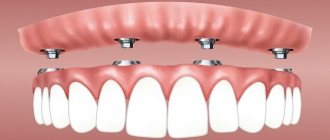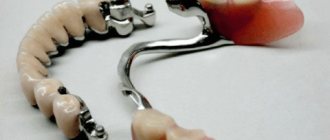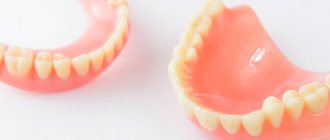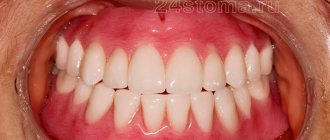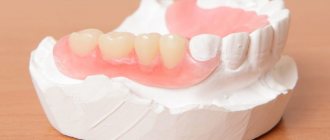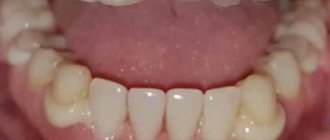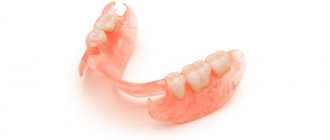In the world of dental prosthetics, an ultra-modern novelty recently appeared - a miniature, comfortable and natural sandwich denture. It suits almost everyone, is easy to clean, and installs quickly and without any problems. Its advantages can be listed endlessly, but it is better to see everything with your own eyes.
Dentistry does not stand still. Specialists are developing new designs and materials that meet modern requirements for aesthetics, comfort, convenience and functionality. This is especially true for implants and dentures, the task of which is to completely replace real teeth. Dental inventions of the new generation include a removable sandwich denture, which is superior to other orthodontic structures in many respects .
Sandwich prosthesis for dental restoration – how it works, what it looks like and who it’s suitable for
Article navigation
- What is a sandwich prosthesis
- History of creation
- Indications
- Contraindications
- What are the advantages
- Flaws
- Stages of prosthetics
- Service life and care rules
- Guarantee
- Where can I do it?
- Reviews
- Price
Question for a specialist
Sandwich prosthesis is a new product in the field of removable prosthetics. In essence, this is a regular overdenture that rests on the gums. However, it differs from similar designs in the presence of locks or attachments that are fixed in the patient’s own teeth, as well as the absence of palatal overlap. Patients note that the sandwich denture is more comfortable and creates the feeling of having their own teeth in the mouth.
Other types of prosthetics for supporting teeth
Let's consider what other options are available for almost complete loss of teeth. The most popular is the clasp one, known in two modifications: with clasps and with locks. Nowadays, clasp dentures with clasps (metal hooks that cling to supporting teeth) are practically not used due to the fact that, regardless of location, the hooks are visible in the mouth, which looks very unaesthetic. Therefore, a new type of such prosthesis was developed - with locks. There are three options for attaching to teeth:
- Telescopic. Special cone-shaped crowns are installed on the supporting teeth, then a prosthesis with a special fastening is put on them.
- Conventional fastening is carried out on crowns, for the installation of which it is necessary to grind down the teeth.
- The attachment type involves installing a locking connection element directly into the abutment tooth without any preliminary preparation. This type of fastening looks the most natural. In essence, it is similar to the sandwich prosthesis technology, but due to the complexity of working out the entire structure, it is much more expensive.
A locking connection is a more modern way of fixing a clasp denture.
The main advantage of such a product is that it allows you to distribute the chewing load as evenly as possible on all the teeth in the mouth. Thus, this helps to maintain healthy teeth, because the natural structure of the jaw is preserved as much as possible with such a prosthesis. In addition, they are very convenient to use because when they are removed and installed, they do not touch the gums and do not have a destructive effect on tooth enamel. The clasp prosthesis does not affect the sense of taste in any way and does not interfere with diction. Disadvantage: any clasp product is several times more expensive than a sandwich prosthesis.
What is a sandwich prosthesis and how does it work?
The new generation “sandwich” prosthesis belongs to the category of removable, or more precisely, conditionally removable. You don't need to remove it every day, but the option remains. Moreover, the patient himself can do this, for example, for hygiene procedures. Dental sandwich dentures are fixed on a special locking mount, which belongs to the group of attachments. It is spherical and is placed directly into the tooth root (there is a second part in the form of a hole inside the prosthesis). The fastening differs from hook-clasps or traditional locks-attachments in its smaller size and also reduces the load on the gum tissue.
PROSTHETICS WITH 6 OSSTEM IMPLANTS FROM RUB 200,000.
Complex implantation Osstem (South Korea) with delayed loading after 4-6 months.
Call now or request a call
The sandwich prosthesis consists of three parts:
- artificial dental crowns – analogues of the patient’s own teeth,
- acrylic base – artificial gum,
- attachments or locks: they consist of two elements - the first part is located in the inner part of the prosthesis, the second - directly on the tooth (or rather, in its root).
You can see what a new generation sandwich dental prosthesis looks like in the photo. A distinctive feature on the upper jaw is immediately noticeable - here you can see that this is a removable denture without a palate (a massive artificial part), so it is more comfortable to wear than classic “removers”. In general, the volume of a sandwich prosthesis is only 15% larger than that of a natural dentition (more precisely, all natural crowns, since the prosthesis also includes an imitation of gums), and its weight is 5-7 grams.
The history of sandwich dentures
“Sandwiches” are the development of Russian orthopedic dentists with 30 years of experience in practical prosthetics. The specialists took into account all the comments and reviews of patients wearing conventional removable appliances (poor fixation, rubbing of the gums, loss of the “jaw”, lisp, lack of taste in food and nausea). And as a result, they created a removable dental sandwich prosthesis. By the way, it is called that not because it is edible, but because of a special patented manufacturing technology - when materials with different physical properties are combined with each other in a certain sequence.
Conditions when a sandwich prosthesis can be installed - indications
- the presence of at least two teeth or their healthy roots, preferably at the edges of the dentition: attachments will be attached to these lateral teeth. However, in some cases, a sandwich prosthesis can also be fixed on the front teeth, if the lateral ones are not preserved,
- wearing a sandwich denture is allowed on both the upper and lower jaws,
- bruxism and malocclusion pathologies: for example, with a mesial or reverse bite, a sandwich prosthesis can also be installed,
- absence of many or all teeth in a row: with the exception of two preserved roots,
- abnormal structure of the sky,
- prosthetics are possible even with severely damaged natural teeth on pre-treated roots,
- restoration of teeth with mobility of 1-2 degrees (with periodontitis1, periodontitis),
- suitable for patients with excessive dry mouth, as it does not block the salivary glands,
- when there are relative or absolute contraindications to implantation.
Indications and contraindications
List of indications for installation of upper removable dentures without palate:
- the presence of at least two healthy teeth or roots (supporting crowns can be placed on them, on which the prosthesis will be fixed);
- lack of bone tissue, diabetes mellitus, blood diseases, etc.;
- increased gag reflex;
- Correction of the bite during the period of change of baby teeth.
Among the limitations of using prosthetic teeth without a palate are allergies to the materials included in the structure and mental illness. In addition, it is impossible to install a removable denture without a palate in the absence of teeth.
Contraindications for prosthetics
- allergic reactions to materials: although they are hypoallergenic, no one is immune from individual intolerance. Therefore, carefully monitor the condition of the oral cavity after prosthetics and especially focus on the appearance of rashes, itching, swelling,
- complete edentia (if there are no teeth at all): in this case, instead of “sandwiches”, classic removable ones (plate or Acry-free) are also suitable, but it is better to still carry out implantation - it’s more reliable,
- the need for complete removal of remaining teeth along with roots,
- late stages of periodontitis or periodontal disease, when the teeth become very mobile and cannot serve as a quality support for prosthetics.
Only until 30.09 South Korean implant Osstem - 19,900 rubles.
Hurry up to sign up for a free consultation and lock in promotional prices.
Call now or request a call
Opening hours: 24 hours a day - seven days a week
What are the advantages of sandwich dentures?
- no need to take it off at night or after meals,
- does not cause a gag reflex,
- the opportunity to enjoy your favorite food, which is not jammed under the prosthetic base: the “sandwich” is perfectly fixed, which means there is no need to be afraid that it will come unstuck or fall out while chewing food. In addition, there is no artificial palate in the design, and taste buds are not blocked,
- the artificial jaw does not move while chewing food, laughing or talking,
- diction doesn't change
- absence of wearing discomfort and rubbing of the mucous membrane: due to the precise fit to the gums, supporting teeth and the presence of a very small artificial gum made of elastic plastics,
- aesthetic smile: compact design, without hooks - often they spoil the appearance and rub the gums,
- quick adaptation due to the minimal size of the prosthetics,
- maintainability and availability of a manufacturer’s warranty (more on this later).
Advantages
The design has a number of advantages. These include:
- There is no need to grind teeth that serve as support.
- Ensuring tight fixation in the patient’s mouth, due to the characteristics of the device. At the same time, the prosthesis does not use additional fixing elements that are visible to prying eyes. There is also no need to use adhesives.
- High speed (on average, two visits to the dental clinic are enough to create).
- There is no need to make a new model due to changes occurring in the oral cavity. The Sandwich prosthesis is easily adjusted , and its repair is very simple and quick.
In addition, the presence of soft connections with the mucosa allows you to adapt to changes without losing a reliable fit. - Long life of at least 10 years.
- High level wearing comfort Due to the fact that the prosthesis does not cover the palate, it does not affect diction and does not change the taste perception when eating. In addition, the prosthesis does not require removal during sleep, and removal can only be performed to perform hygienic procedures.
- High elasticity at the level of nylon prostheses.
Along with the above, the “Sandwich” denture has another significant advantage - food debris does not get clogged . This is achieved due to the presence of additional soft covering elements covering the mucous membrane from the sides.
This effect is ensured by a tight fit and the use of elastic compounds in places of contact with the mucosa, which create good adhesion and prevent contamination of the cavity under the prosthesis.
Disadvantages of sandwich dentures
Sandwich dentures also have disadvantages. Firstly, they are somewhat more expensive than traditional removable ones, because their production is more complicated. Secondly, they are not suitable for patients with nervous system disorders, or those with allergic reactions to materials. Thirdly, a “sandwich” can be installed only if there are at least two natural teeth in a row, the roots of which are suitable for fastening. However, there is a risk of damage to the supporting teeth - over time, the roots may simply split into pieces due to excessive stress.
Not a single removable denture, even the most modern one, protects the jaw from atrophy (or loss) of bone tissue in those places where tooth roots were previously located, but now they are not there. Over time, the height and width of the alveolar process decreases, and the level of the gum also decreases - so the “pullers” become uncomfortable, begin to shift, and you have to go to the dentist for correction. Now dentistry can offer only one solution to prevent bone atrophy - implant prosthetics.
Is it possible to install a denture without a palate in the absence of teeth in the upper jaw?
Orthopedic devices without a plate are not installed in completely edentulous patients. It is necessary to have a jumper that will hold the device.
An alternative to removable prosthetics is implantation with the installation of a bridge. The most popular technology is All-on-4. The design is completely devoid of a bulky base. Attached to implants fixed in the bone. Implants transfer the load to the bone tissue, which slows down atrophic processes. Prostheses on implants function for 15 years. When using quality materials, the results last a lifetime.
Stages of prosthetics - preparation, construction and installation
Let's take a closer look at how a sandwich prosthesis on spherical attachments functions and is installed, as well as how it is manufactured.
At the first stage, the supporting teeth are prepared for installation of the prosthesis. The crown is processed, the degree of tooth mobility, the direction of root growth are assessed, and then the nerve is removed from the root canals (but this is not always necessary) and infectious foci, if any. Afterwards, the root is filled and an oval-shaped cavity is created in it. A root spherical attachment is placed inside it, which protrudes above the gum. It is secured with a special fixing material.
At the second stage, impressions are taken, according to which individual prostheses are created in the laboratory. On average, the sandwich dentures will be ready in 2-3 weeks. It is worth noting that the second part of the attachment (which is located inside the prosthesis) is worked out by the dental technician - it is a recess into which the spherical part is placed, located on the supporting tooth. As soon as the two elements are connected, the mount snaps into place and securely fixes the orthopedic structure in the oral cavity.
At the third stage, the sandwich prosthesis undergoes final fitting. If it does not cause discomfort or put pressure on the gums, then the work is considered completed - the doctor will definitely teach the patient the rules for caring for new teeth, and will also explain how to remove and install the denture independently.
How does the installation work?
The process of installing the prosthesis and preparing for it is very simple.
At the first visit to the dentist, a specialist examines the oral cavity. This is done in order to prescribe treatment or implantation, if necessary. In the presence of any dental diseases (caries, pulpitis, gingivitis), treatment is carried out. The teeth that will become the frame of the prosthesis must be healthy . If there are no natural teeth, implantation is carried out: then the structure will be installed on crowns. If only roots are present, depulpation may be necessary followed by installation of a crown.
Photos of the measurement and installation process
Sometimes, in preparation for prosthetics, drug treatment is required to eliminate inflammatory processes in the mouth and strengthen the mucous membrane.
The next step is to take a panoramic photo. A sandwich prosthesis is created taking into account individual dental characteristics, therefore, to accurately reproduce a number of your own teeth in an artificial form, an image is required.
The dentist then makes an impression, which will be needed to create a custom prosthesis.
Casts for production
Production time usually does not exceed 7-10 days. Once the design is ready, the patient is contacted and a date for the next visit is set.
First, the prosthesis is tried on. If the patient is comfortable and the device is correctly positioned in the mouth, it is attached to his own teeth or prepared crowns. If necessary, the system is adjusted on the spot. After installation, the doctor gives recommendations on how to care for the product.
Service life and care rules
The service life of a prosthesis on attachments largely depends on the initial condition of the supporting teeth. The longer they can withstand the load, the longer the life of artificial teeth will be. In general, sandwich dentures will last 7 years or more.
The patient also needs to remember to take careful care of both the gums and attachments in the roots of the teeth, and the “sandwich” itself. At the slightest inflammation of the mucous membrane, it is very important to carry out complex therapy (rinses, baths), otherwise there is a high risk of infection of the roots and gums.
The denture itself must be cleaned 2 times a day with a brush and paste, and after eating, be sure to rinse your mouth. No need to take it out! It is recommended to remove the prosthesis 2-3 times a month for detailed cleaning of the inner surface using special solutions that are sold in pharmacies. You should also visit your orthopedist 2-3 times a year for preventive measures (professional cleaning of the prosthesis and its adjustment if necessary).
Where can such a prosthesis be made?
Where to install a dental sandwich prosthesis? Sandwich structures are manufactured and installed in only one clinic in Russia - the Moscow dentistry "Persona Life". This is where the creators of the patented “sandwich” work. Moreover, the rights to the patent and manufacturing techniques were not transferred to anyone, so the removable “sandwich” is available only to a limited circle of patients living in the capital or having the opportunity to visit it regularly - after all, the prosthesis will have to be adjusted regularly.
Don't know what type of prosthetics to choose?
We will help in the selection, advise where to read more information and compare types of prosthetics.
Consultation with an orthopedic doctor in Moscow clinics is free! Call now or request a call
Working hours: from 9:00 to 21:00 - seven days a week
Price
Since a removable denture is made from high-quality imported materials, it is expensive and not available to all dental patients. The average price starts from 35,000-40,000 rubles. The cost varies greatly, depending on the number of missing teeth in the jaw and the list of dental services.
What matters is the choice of city, the reputation of the clinic and the specific doctor. If we talk about prices in Ukraine, for example, in Dnieper they start from 10,000 UAH. and higher. But the result is worth it!
Reviews from real patients
“I wore all sorts of prosthetics – both plate and clasp ones, but something always got in the way. I just couldn’t find a good option for myself so that I wouldn’t feel sick or feel heavy. And then one day I read about sandwich dentures on the World Wide Web. Then I went to a consultation, where I really liked everything, and I decided to use them. I will say right away that the expectations were justified and even very much so. The convenience simply cannot be compared with the old removable jaw.”
Irina Mikhailovna, review from the site irecommend.ru
“Our grandfather was left with almost no teeth at the age of 70. I wanted to do it for free with my pension, but there is a huge queue there. They began to look for other options, but not very expensive ones, because he himself was uncomfortable when someone helped. We settled on domestic “sandwiches”, although we had to go to Moscow to get them. Grandfather is happy so far, wears new teeth and doesn’t complain.”
Alexander, review from forum.stom.ru
What satisfied consumers say
“I had the opportunity to try different prostheses on myself, and last time my friends suggested that I go to a clinic where they install so-called sandwich structures. I decided to experiment, and did not regret my choice at all. In terms of comfort and convenience, this is the best I've come across. Any prosthesis takes some time to get used to, but here it immediately fit like a glove and didn’t rub anywhere.”
Maslov R.D., 54 years old, Moscow, from correspondence on a thematic forum
“I’m now raising money for implantation, but for now I had to install a removable denture. I spent a long time choosing a model, consulting with friends, and ultimately chose the sandwich model. What can I say from myself: adaptation took literally days, I didn’t notice any speech disturbances, or any problems with eating. The new teeth look very natural, and if you don’t look closely, you can’t tell the difference at all. I give this sandwich a solid ten. I’m very glad that I chose him.”
Luba65, Moscow, review on the website irecommend.ru
Cost of a sandwich prosthesis with attachments
How much does a sandwich prosthesis cost? The cost of a new generation denture with attachments starts from 53.5 thousand rubles per jaw. The amount includes the price of the removable sandwich denture itself, diagnostics of the condition of the oral cavity before treatment, adjustments during the manufacturing process and final fixation of the denture, as well as service. Moreover, for the treatment of supporting teeth, if it is required, you will have to pay separately - about 10 thousand rubles for 1 tooth.
The amount is quite large (compared to plate acrylic ones), but the comfort and convenience cannot be compared with any other type of removable structures. Except, perhaps, implantation, but it will cost 2-3 times more.
- Orekhova L.Yu. Periodontal diseases, 2004.
Author: Namdakov N.V. (Thank you for your help in writing the article and the information provided)
Conditionally removable dentures
There are also conditionally removable dentures. They are called this because the patient cannot remove them on his own. Most often, this type of prosthetics is used when a person is missing a large number of teeth. In this case, they are attached to implants. Advantages of conditionally removable dentures:
- reliability of fixation;
- do not cause discomfort;
- lighter in weight than removable counterparts;
- lower cost.
The following stages of installation of prostheses are distinguished:
- implantation;
- installation of abutments;
- production from casts;
- preliminary fitting, correction (if necessary);
- fastening.
There are several types of fastenings:
Types of prosthesis fastening. From left to right: screw, spherical, beam
- spherical. It is a small lock that looks like a ball. It assumes the presence of special recesses inside the structure, matching the shape of the abutment (the size is slightly smaller). This type of fastening is not considered reliable due to frequent breakdowns;
- beam Special beams are installed on implants and conditionally removable dentures, which snap into place when connected. More reliable than the previous method;
- screw It is the most reliable mount. It is fixed with special screws. Advantages: durability, does not require long-term adaptation, the doctor can easily remove the structure for cleaning without damaging the implant. The disadvantages include the need for periodic visits to the doctor for hygiene procedures and the relatively high cost when compared with other methods.
Clasp dentures and “sandwiches” have significant differences from each other, both in the material of manufacture and in the type of attachment to the supporting teeth. Due to their more advanced performance and quality characteristics, clasp dentures have a higher cost. Sandwich dentures are cheaper, but also have good performance characteristics. To choose a particular product, you should first of all consult with your dentist.
